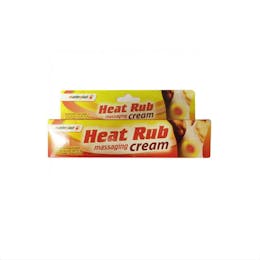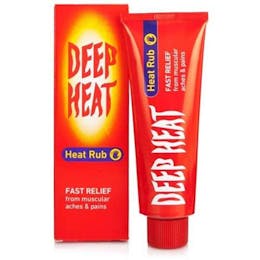Sprays & Rubs
Instant relief from pain and discomfort. Apply heat sprays to the affected area to soothe aching muscles, stiffness & chronic injuries. Freeze sprays help to treat acute injuries such as strains, sprains, swelling and bruising.

Fast-acting spray that cools, soothes, and relieves pain instantly

Rub into affected area to give a warming effect. Relieves aching joints and muscles

Helps stimulate circulation, relax stiffness and can re-oxygenate tense, painful tissues


- Leading brand Deep Heat Spray provide instant, long lasting relief
- Instant hot therapy treatment specific to your injury type
What is 'PRICE' (protection, rest, ice, compression, and elevation) Therapy?
For minor injuries such as sprains or strains, the below advice is normally effective for pain relief and recovery. PRICE therapy is suitable for initial treatment of injuries and can be used at home for two-three days after the initial injury. PRICE stands for Protection, Rest, Ice, Compression and Elevation.
Protection
Protecting the area from further injury is extremely important. When we are injured, we will not have our full range of movement which will likely make us a little clumsier. Using a support and being extra careful will ensure that your injury does not get worse.
Rest
Avoiding exercise and reducing your daily physical activity will help speed up your recovery. If you absolutely must move, consider using an aid to make sure you don't put undue pressure on the injury. A walking stick may help for leg injuries and a sling may help for arm and shoulder injuries.
Ice
Applying an ice pack to the injured area for 15 - 20 minutes every 2 - 3 hours will help ease the pain by numbing the nerve endings and help reduce swelling in the area. We recommend Koolpak Instant or Reusable Ice Packs with an Ice Pack Cover to prevent the pack touching your skin which can lead to irritation and ice burn.
Compression
Using an elasticated compression bandage on the injury helps to limit swelling and will ease pain. Compression bandages come in a variety of sizes, so make sure you use one that is the right size. Too small and the bandage could do more harm than good.
Elevation
Keeping the injured body part elevated above the level of your heart will help reduce swelling and help speed up recovery.
When To Use Cold Therapy

Acute Injuries and Inflammation
Cold therapy is effective immediately after an injury. It helps reduce pain and swelling by constricting blood vessels, limiting blood flow to the affected area, which in turn minimises inflammation. Research consistently supports the use of cold therapy for managing acute injuries, making it a key component of early injury treatment.

Post-Exercise Recovery
Applying cold therapy after intense physical activity can help minimise muscle soreness and accelerate recovery. Studies show that cold-water immersion and similar cold treatments are beneficial in reducing exercise-induced muscle damage, thereby aiding in quicker recovery times.

Migraines and Headaches
Cold therapy, often in the form of cold packs or compresses, can be effective in relieving migraines and tension headaches. Research indicates that cold therapy can help manage headache symptoms by numbing the pain and reducing inflammation in the affected areas.
When To Use Hot Therapy

Muscle Relaxation and Chronic Pain
Heat therapy is effective for relaxing muscles and alleviating chronic pain conditions. Applying heat increases blood flow and oxygen delivery to the affected area, which promotes muscle relaxation and reduces stiffness. This makes heat therapy a valuable tool for managing conditions like chronic back pain or muscle tension.

Pre-Exercise Warm-up
Using heat therapy before physical activity can enhance flexibility and performance. Pre-exercise heat application is shown to positively influence muscle function and range of motion, preparing the body for more strenuous activity.

Joint Stiffness
Heat therapy is particularly beneficial for managing joint stiffness, especially in conditions such as osteoarthritis. By increasing blood circulation and relaxing the surrounding muscles, heat improves joint flexibility and reduces the discomfort associated with stiffness.